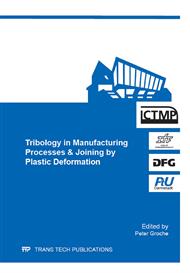[1]
Mori, K.; Bay, N.; Fratini, L.; Micari, F.; Tekkaya, A. E.: Joining by plastic deformation. CIRP Annals – Manufacturing Technology 2013, Volume 62, Issue 2, 2013, pages 673–694.
DOI: 10.1016/j.cirp.2013.05.004
Google Scholar
[2]
Popov, V. L.: Contact Mechanics and Friction. 2009 Springer-Verlag Berlin Heidelberg, ISBN 978-3-540-88836-9 e-ISBN 978-3-540-88837-6.
DOI: 10.1007/s11249-010-9673-6
Google Scholar
[3]
Schätzle, W. : Querfließpressen eines Flansches oder Bundes an zylindrischen Vollkörpern aus Stahl (engl.: Lateral extrusion of a flange or collar to solid cylindrical bodies made of steel). Berichte aus dem Institut für Umformtechnik. Hrsg.: Prof. Dr. -Ing. K. Lange. Springer-Verlag, Dissertation (1987).
DOI: 10.1007/978-3-642-83129-4
Google Scholar
[4]
Dörr, F. and Liewald, M.: Werkzeugkonzept und Verfahrensentwicklung zum Umformfügen einer Welle-Nabe-Verbindung durch Kalt-Quer-Fließpressen (engl.: Tool design and process development of a joining by forming process to manufacture a shaft-hub-connection by lateral extrusion). 5. VDI-Fachtagung: Welle-Nabe-Verbindungen: Gestaltung – Fertigung – Anwendungen; 25. – 26. September 2012, Nürtingen near Stuttgart.
DOI: 10.51202/9783181022870-189
Google Scholar
[5]
Reinholz, R.: Tragfähigkeit von P3G-Welle-Nabe-Verbindungen bei Dauerschwing-beanspruchung (engl.: Load capacity of P3G shaft-hub-connections in fatigue loading), Dissertation, Fachbereich Maschinenbau und Produktionstechnik der Technischen Universität Berlin, ISBN 3-7983-1607-4, Berlin, (1994).
Google Scholar
[6]
Deters, L.; Fischer, A.; Santer, E.; Stolz, U.: Tribologie: Verschleiß, Reibung (Definitionen, Begriffe, Prüfung) (engl.: Tribology: Wear, Friction (Definitions, Terms, Test). Gesellschaft für Tribologie, Arbeitsblatt 7, Ausgabe August (2002).
Google Scholar
[7]
Dörr, F.; Funk, M.; Liewald, M.; Binz, H.: Numerical investigations on stress distribution and deformation of shaft-hub-connections manufactured by lateral extrusion. NUMIFORM 2013, Shenyang, China, 6. -10. Juli (2013).
DOI: 10.1063/1.4806843
Google Scholar
[8]
Tibari, K.: Grundlagen des fluidbasierten Fügens hohlförmiger Rahmenstrukturen bei simultaner Formgebung (engl.: Fundamentals of fluid-based joining of hollow shaped frame structures by simultaneously forming). Dissertation, Berichte aus Produktion und Umformtechnik, PtU Darmstadt, Shaker Verlag Aachen, (2007).
Google Scholar
[9]
Mandić, V. and Stefanović, M.: Friction Studies Utilizing the Ring Compression Test – Part 1. in: Tribology in industry, Volume 25, No. 1&2, 2003, pages 33-40.
Google Scholar
[10]
Hagedorn, M.: Herstellung von Verbundbauteilen durch Einwalzen (engl.: Production of composite components by rolling). Dissertation, Universität Dortmund, Vulkan Verlag, 2005; ISBN: 3-8027-8730-7.
Google Scholar
[11]
Winterfeld, J.: Einflüsse der Reibdauerbeanspruchung auf die Tragfähigkeit von P4C-Welle-Nabe-Verbindungen (engl.: Influences of the frictional stress on the load capacity of P4C-shaft-hub-connections). Dissertation, Technischen Universität Berlin, (2001).
DOI: 10.51202/9783181022870-65
Google Scholar
[12]
Steinhäuser, S.; Wielage, D.; Dietrich, D.; Lampke, Th. and Gropp, H.: Phosphate coatings against frictional corrosion at shaft-hub press-fit connections and as transmission element for forces and moments in press-fit connections. in: Journal of Electrochemistry and Plating Technology, Eugen G. Leuze Verlag, 1/2008, pages 5-24.
Google Scholar


